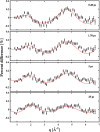The Ring-Closing Reaction of Cyclopentadiene Probed with Ultrafast X-ray Scattering
- PMID: 38709555
- PMCID: PMC11215772
- DOI: 10.1021/acs.jpca.4c02509
The Ring-Closing Reaction of Cyclopentadiene Probed with Ultrafast X-ray Scattering
Abstract
The dynamics of cyclopentadiene (CP) following optical excitation at 243 nm was investigated by time-resolved pump-probe X-ray scattering using 16.2 keV X-rays at the Linac Coherent Light Source (LCLS). We present the first ultrafast structural evidence that the reaction leads directly to the formation of bicyclo[2.1.0]pentene (BP), a strained molecule with three- and four-membered rings. The bicyclic compound decays via a thermal backreaction to the vibrationally hot CP with a time constant of 21 ± 3 ps. A minor channel leads to ring-opened structures on a subpicosecond time scale.
Conflict of interest statement
The authors declare no competing financial interest.
Figures







References
-
- Emma P.; Akre R.; Arthur J.; Bionta R.; Bostedt C.; Bozek J.; Brachmann A.; Bucksbaum P.; Coffee R.; Decker F.-J.; et al. First lasing and operation of an ångstrom-wavelength free-electron laser. Nat. Photonics 2010, 4, 641–647. 10.1038/nphoton.2010.176. - DOI
-
- Yong H.; Xu X.; Ruddock J. M.; Stankus B.; Carrascosa A. M.; Zotev N.; Bellshaw D.; Du W.; Goff N.; Chang Y.; et al. Ultrafast X-ray scattering offers a structural view of excited-state charge transfer. Proc. Natl. Acad. Sci. U. S. A. 2021, 118, e2021714118.10.1073/pnas.2021714118. - DOI - PMC - PubMed
-
- Yong H.; Zotev N.; Stankus B.; Ruddock J. M.; Bellshaw D.; Boutet S.; Lane T. J.; Liang M.; Carbajo S.; Robinson J. S.; et al. Determining orientations of optical transition dipole moments using ultrafast X-ray scattering. J. Phys. Chem. Lett. 2018, 9, 6556–6562. 10.1021/acs.jpclett.8b02773. - DOI - PubMed
Grants and funding
LinkOut - more resources
Full Text Sources
Miscellaneous

